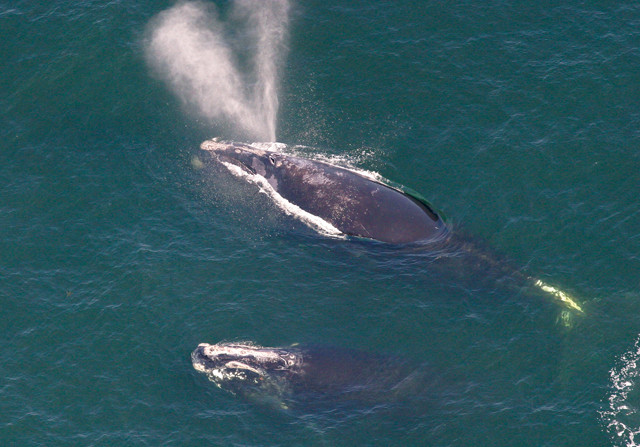
by Mary Caperton Morton Thursday, January 7, 2016

Baleen whales, such as these North Atlantic right whales, are filter feeders that sieve krill and other microorganisms through plates of baleen attached their jaws. Credit: NOAA/NEFSC, Peter Duley.
The evolution of baleen whales from toothed whales was gradual, with intermediate fossil species found that possess both teeth and baleen. Now, the discovery of three new whale species on New Zealand’s South Island is filling in the evolutionary story of baleen whales.
The newly-described species — Waharoa ruwhenua, Tokarahia kauaeroa and Tokarahia lophocephalus — are all eomysticetids, a family of baleen whales dating to the Late Oligocene between about 35 million and 25 million years ago. Waharoa appears to be a fully baleen whale, but the two Tokarahia species may be transitional animals between primitive toothed baleen whales and modern baleen whales, Robert Boessenecker of the University of Otago in New Zealand and colleagues reported in the journal PeerJ.
“The skulls of these three specimens were spectacularly preserved, revealing that eomysticetids had unusually long and delicate surfboard-like snouts, with blowholes placed far forward on the skull, and enormous attachment areas for jaw muscles,” Boessenecker said in a statement. The delicate nature of the jaws and skulls indicates that the 5- to 6-meter-long whales were likely not lunge feeders like humpback whales, but were adapted for skim feeding like right whales — “they would have been a sort of slow-cruising vacuum cleaner for krill,” he said.
Isotopic analyses of the bones suggested that the whales were undertaking north to south migrations in the Southern Ocean, around the continent of Zealandia, which at the time existed as a collection of small islands surrounded by shallow seas. The area may have been a calving ground; at least one small juvenile was recovered. The whales represent three of the five known members of the Eomysticetidae family to have been identified in the Southern Hemisphere.
© 2008-2021. All rights reserved. Any copying, redistribution or retransmission of any of the contents of this service without the expressed written permission of the American Geosciences Institute is expressly prohibited. Click here for all copyright requests.